A TALE OF TWO TROUT STREAMS
Actually the same trout stream, same time of the year, but what a difference the twelve months between September 2008 and September 2009 have made on this one little spring creek in northeast Iowa. The stream is stocked with catchable size (between nine and twelve inches) rainbow and brook trout. One of the tributaries is seeded with fingerling browns, so by the time they find their way to the public water and are big enough to catch, they are as wild as they would be if they were born there. There are several miles of public water, and it’s no secret by any means, but part of the fun for me was finding the place so I’ll not go and spoil your fun by naming names. The whole driftless region of Iowa, Minnesota and Wisconsin is beautiful country and well worth the exploring. There are better fishing streams than this one, some with wild reproducing fish, but this one has charms of its own that have captured my fancy so I’m sticking with it for awhile. We’re getting to know one another quite well.
I first discovered it in 2005, while exploring the area with some friends. We were making a whirlwind, eight day tour of as many Iowa trout streams as we could. We covered this one and two others in one day, so needless to say, we only saw enough for me to know I wanted to come back and see more. At that time the DNR had just finished some in-stream improvements and sections of the creek looked a bit like a construction project since nature hadn’t quite reclaimed the banklines yet. But I was intrigued.
By 2007, I had talked about it a lot, but never gone back. Marguerite and I were married in October of that year, and the folks at work chipped in and got us a gift certificate for a cabin near the stream as a wedding present. We had fished it in the spring the first time, but my wife wanted to see the fall foliage again (we had honeymooned in Minnesota) so we decided to make it a first anniversary trip and reserved the cabin for the third weekend in September. A few weeks before our actual anniversary, but a better time for both the weather and the fall foliage, and also it meant we were out of the woods before hunting season started.
Then came the spring of 2008, and along with it came rain, lots of rain. The driftless region was adrift with floodwater. The three major rivers that drain the area all spent time way out of their banks and the tributaries fared little better. A lot of silt was moved, beds were scrubbed free of vegetation and, in some cases, and fish habitat was damaged. I knew the water would be back down by September of course, but I began to wonder if I would recognize the little creek I’d fallen in love with. A few weeks before the trip, when I called to confirm our reservations, I was assured that while the water was still a bit higher than normal, the stream was fishing pretty well and there had been no major damage. I was relieved, but still curious as to what things would look like.
We got there and, yes, the stream was different. Three years will do that, even without a flood. But it was recognizable. The water was clear and the stream bed was almost completely free of vegetation. It was also full of trout. No surprise since they stock it once a week, but we were pleasantly surprised when Marguerite’s first fish (her first trout ever) was a nicely colored brook trout and her second was one of the wild browns.
The weather was perfect that week. Actually a bit too perfect as the clear skies and bright sun made the fish pretty shy without any cover to offer them protection. Once the sun got over the bluffs each morning the fish would head for the cut banks and the bottom of the few deep holes the creek has to offer. Not a total loss, though. We would get up early, fish the morning until the fish quit biting, then go back to the cabin and eat breakfast. After that we would head into town and do a little exploring. We toured the local fish hatchery, found a couple museums and shops, or stayed at the cabin and relaxed until the sun started to come off the water, at which time, the fish would come out and begin to feed again.
I did a lot of rock tipping while we were there that week. Case-building caddis larva covered the bottoms of the rocks in many parts of the stream, but since the main hatches in the area occur in the spring and early summer, we saw no adults. We also found good populations of leeches and sowbugs (quite unexpected given the lack of vegetation), but encountered very few of the tiny olive mayfly nymphs that my prior research had led me to expect.
I took that information home with me, along with a couple books I was able to find on the area’s bugs and flies to imitate them. We had such a good time that we immediately booked the cabin for the same time this year. I had twelve months now to study, tie flies, and try to turn what I learned into even greater success when we returned, knowing full well how much can change in that time.
My first hint that things would be a bit different this year came as I started watching the weather reports a week or two before our trip. A cold snap settled over northeast Iowa, and rain was in the forecast for most of the week we would be there. Of course a little cloud cover would be a good thing since the fish would be a little more likely to show themselves all day and the bugs would be a little more active. But how much rain? I got more and more excited as the trip drew nearer.
When we got there, it was almost the exact opposite of last year. Forget blue skies. Most of the time it was cloudy, foggy, rainy, or sometimes all three at once. Actually though, it wasn’t so bad. The temperature stayed in a comfortable range and the rain was mostly just showers off and on. The fog was really quite pretty and added a sense of mystery to the surroundings. I especially enjoyed being on the water in the evenings as the mists began to rise up and close in around you. By morning the entire valley would be shrouded, sometimes not burning completely off until almost noon.
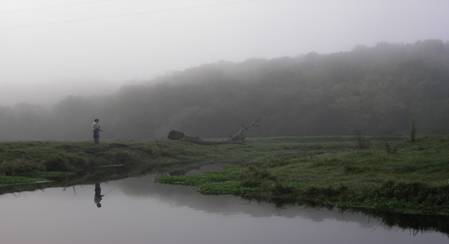
The water was lower and even clearer than the year before, but the plant life made all the difference in the world. That next morning, Marguerite went into town with a couple friends who were sharing the cabin with us this time, which left me the whole day to explore the creek. I slipped on my hip boots and off I went. I tied on a yellow trude as an indicator. Behind that I attached a pale yellow soft hackle in about the same size as the craneflies from the night before. Good thing I brought the fly tying kit along this time. I found a likely looking riffle below a long pool and began casting. The soft hackle hung in the surface film just as I hoped it would. About the third cast, the trude stopped dead in the water at the same time as I saw a swirl behind it. I lifted the rod and the fight was on. Like last year, the first fish of the week wasn’t one of the freshly stocked rainbows, but a brown of about ten inches. Not huge, but not bad for such small water. He had taken the soft hackle. The next fish, a rainbow, took the trude. I fished my way up the riffle and into the tail of the pool. As I worked my way up the little creek, I picked up a fish here and there, mostly on the soft hackle, but occasionally on the trude as well. Mostly it was rainbows, but there were an encouraging number of browns as well. Oddly, I didn’t catch any of the brook trout that should have been there, too.
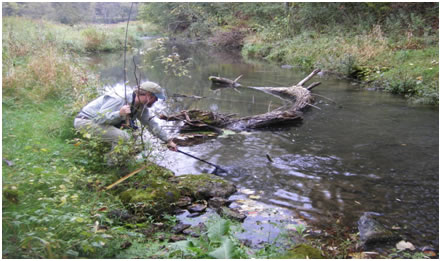
At the same time the vegetation gave the fish a little more shelter, a little more food, and a little more confidence, it complicated things for the fisherman. Where last year the drifts were relatively easy and the currents pretty consistent, this year the weeds created channels and braids and islands, all contributing to make the fishing a bit more technical. Instead of being able to drift a fly the entire length of a small pool without drag, I now found myself having to dissect runs in my mind and fish them bit by bit to avoid drag, snags, and to reach lies separated by line-catching islands of cress and weeds.
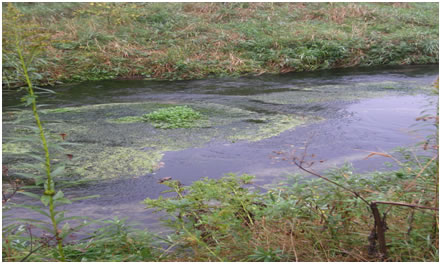
As the day progressed, the fish quit hitting both the soft hackle and the trude. Indeed, by noon there were few rises at all and I began the search for the right nymph. Last year it was a beadhead hare’s ear in a size 16 that had caught most of the fish the entire week. This time, however, they didn’t seem nearly as interested in it. The books I picked up last time around had been right about the soft hackle for the little yellow craneflies, so I decided to take the author’s advice one more time and tied on a #20 flashback pheasant tail in hopes that the tiny olive mayflies might have returned. So far I’d seen no evidence of them, but the fish apparently had because that pattern not only worked, but would prove to be the most effective pattern for the whole week. I kept the trude on as an indicator, but didn’t have any more rises to it until later that evening when fish again started rising to a hatch. It was already too dark for me to determine what it might be.
My wife found herself in a non-fishing mood for much of the trip, so the next days mostly followed the pattern from the year before. I got up early and fished through the morning, with her either sleeping in or going along to photograph the fall foliage and scenery (and the occasional fish when the opportunity arose), then spending the middle of the day sightseeing. In the evening we would return to the river to fish and watch the mist close in.
The third morning the craneflies didn’t appear, and the soft hackle remained undisturbed in the film. So, I made the switch to the pheasant tail, got action in the riffles, but nothing in the pools. There were also a lot fewer rises in the pools than previous mornings and they were a lot more random. Cruising fish? I took the trude off and went to an elk hair caddis for an indicator, thinking I could skitter it along a little and get some attention. It worked, but not the way I thought it would. I tossed the rig into the riffle at the head of a tiny pool and let it slide into the top of the pool before giving it a quick twitch, then another, then another as it drifted through the pool. Nothing had happened yet when the fly started to drag, so I picked it up and cast again, this time the caddis disappeared after the second twitch and I had the first brook trout of the trip. He wasn’t big, even for brookies in the area, which are stocked as “catchable size” just like the rainbows. In fact, he was a lot smaller. Small enough to be wild? Maybe. I’ve heard rumors that they were reproducing naturally in some of the streams in the region, but it could have been mixed in with the fingerling browns as well. No matter, it was still a beautiful little fish. We snapped a quick picture and sent him on his way. What surprised me, though, was that he had taken the nymph on the twitch, not the caddis. I kept fishing it that way and continued to catch rainbows, a couple browns, and another brookie, this one certainly a hatchery fish, but all hit the nymph and hit it when I twitched the caddis.
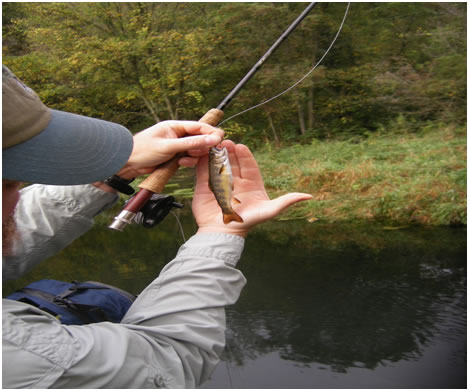
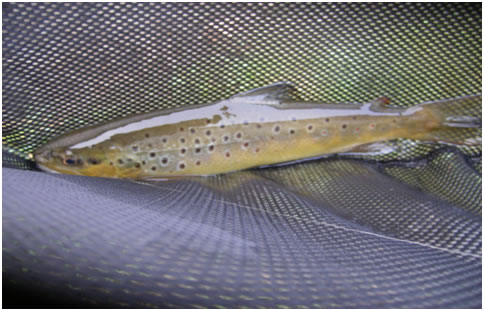
Three more days went by in much the same way (we did take most of one day off the water to visit Effigy Mounds National Monument) and the fish continued to be generous, the trees showed more and more brilliant colors, shedding just enough leaves to look pretty on the water but not enough to be much of a hindrance to casting, and before we knew it, it was once again time to head home. I think all such trips need to have an ending, if for no other reason than to remind us to really take the time to enjoy them while they last, to notice and record in our memories the small details that make them each unique. And this little stream had given me yet another unique week of getting to know it and learning its secrets, at least a few of them. Like this time, next time the place will have changed again, the best things usually do. But I’ll have just that little bit of new information from this trip to help decode the new puzzles I’m presented next time around. It has been said that you can never cross the same river twice. I would offer the corollary that you can’t fish the same river twice either. Just because things should have an end doesn’t mean we have to enjoy seeing it arrive. I’m back in the world of work and responsibility now, but I’m already tying flies, looking through the photos from this and the two previous trips, and itching to be on the water again.
